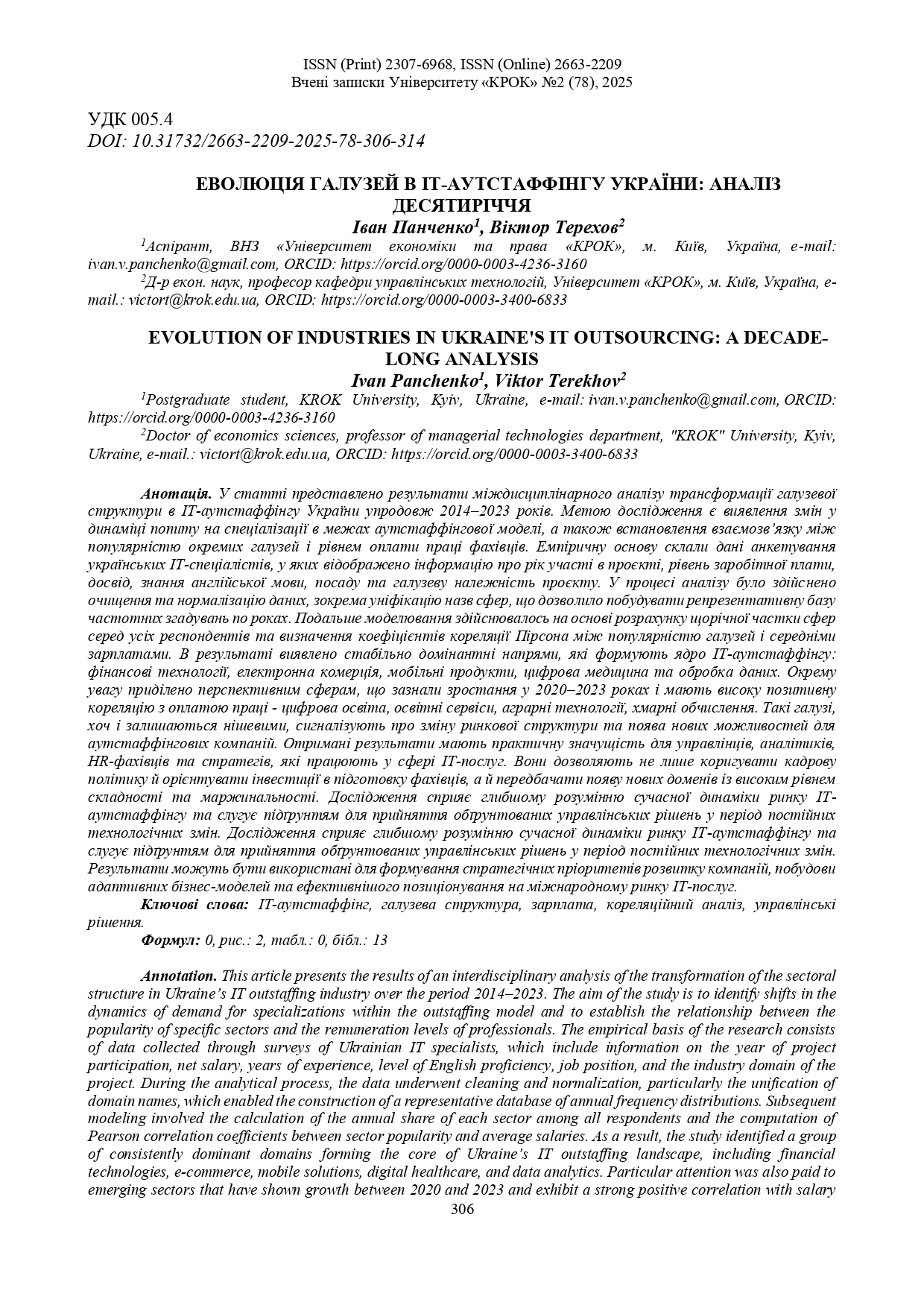ЕВОЛЮЦІЯ ГАЛУЗЕЙ В ІТ-АУТСТАФФІНГУ УКРАЇНИ: АНАЛІЗ ДЕСЯТИРІЧЧЯ
DOI:
https://doi.org/10.31732/2663-2209-2025-78-306-314Ключові слова:
ІТ-аутстаффінг, галузева структура, зарплата, кореляційний аналіз, управлінські рішенняАнотація
У статті представлено результати міждисциплінарного аналізу трансформації галузевої структури в ІТ-аутстаффінгу України упродовж 2014–2023 років. Метою дослідження є виявлення змін у динаміці попиту на спеціалізації в межах аутстаффінгової моделі, а також встановлення взаємозв’язку між популярністю окремих галузей і рівнем оплати праці фахівців. Емпіричну основу склали дані анкетування українських ІТ-спеціалістів, у яких відображено інформацію про рік участі в проєкті, рівень заробітної плати, досвід, знання англійської мови, посаду та галузеву належність проєкту. У процесі аналізу було здійснено очищення та нормалізацію даних, зокрема уніфікацію назв сфер, що дозволило побудувати репрезентативну базу частотних згадувань по роках. Подальше моделювання здійснювалось на основі розрахунку щорічної частки сфер серед усіх респондентів та визначення коефіцієнтів кореляції Пірсона між популярністю галузей і середніми зарплатами. В результаті виявлено стабільно домінантні напрями, які формують ядро ІТ-аутстаффінгу: фінансові технології, електронна комерція, мобільні продукти, цифрова медицина та обробка даних. Окрему увагу приділено перспективним сферам, що зазнали зростання у 2020–2023 роках і мають високу позитивну кореляцію з оплатою праці - цифрова освіта, освітні сервіси, аграрні технології, хмарні обчислення. Такі галузі, хоч і залишаються нішевими, сигналізують про зміну ринкової структури та поява нових можливостей для аутстаффінгових компаній. Отримані результати мають практичну значущість для управлінців, аналітиків, HR-фахівців та стратегів, які працюють у сфері ІТ-послуг. Вони дозволяють не лише коригувати кадрову політику й орієнтувати інвестиції в підготовку фахівців, а й передбачати появу нових доменів із високим рівнем складності та маржинальності. Дослідження сприяє глибшому розумінню сучасної динаміки ринку ІТ-аутстаффінгу та слугує підґрунтям для прийняття обґрунтованих управлінських рішень у період постійних технологічних змін. Дослідження сприяє глибшому розумінню сучасної динаміки ринку ІТ-аутстаффінгу та слугує підґрунтям для прийняття обґрунтованих управлінських рішень у період постійних технологічних змін. Результати можуть бути використані для формування стратегічних пріоритетів розвитку компаній, побудови адаптивних бізнес-моделей та ефективнішого позиціонування на міжнародному ринку ІТ-послуг.
Завантаження
Посилання
Benaroch, M., Lichtenstein, Y., & Fink, L. (2016). Contract design choices and the balance of ex-ante and ex-post transaction costs in software development outsourcing. MIS Quarterly, 40(1), 57–82. https://doi.org/10.25300/MISQ/2016/40.1.03
Digital State UA. (2022). Ukraine's IT shift: From outsourcing to innovation. https://digitalstate.gov.ua/news/it-outsourcing/ukraines-it-shift-from-outsourcing-to-innovation
DOU. (2014–2023). Зарплатні опитування ІТ-спеціалістів. DOU.ua. https://dou.ua/lenta/tags/зарплати/
Ganeshan, M. K., & Vethirajan, C. (2023). Impact of COVID-19 pandemic on information technology sector. International Journal of Clothing Science and Technology, 3(14), 443–448. https://www.researchgate.net/publication/371155889
Karimi-Alaghehband, F., & Rivard, S. (2020). IT outsourcing success: A dynamic capability-based model. The Journal of Strategic Information Systems, 29(2), 101599. https://doi.org/10.1016/j.jsis.2020.101599
Krupka, M., Voytovych, L., Paitra, N., Rubakha, M., Tkachyk, L., & Demchyshak, N. (2024). The impact of IT exports on economic development: A comparative analysis of Ukraine and European countries. Financial and Credit Activity: Problems of Theory and Practice, (58), 314–330. https://doi.org/10.55643/fcaptp.5.58.2024.4446
Mtsweni, P., Mokwena, S., & Moeti, M. (2021). The impact of outsourcing information technology services on business operations. SA Journal of Information Management, 23(1). https://doi.org/10.4102/sajim.v23i1.1361
Oshri, I., Kotlarsky, J., & Willcocks, L. (2019). The handbook of global outsourcing and offshoring (3rd ed.). Palgrave Macmillan.
Suryanarayana, K. N. (2023). E-commerce growth and its implications for consumer behavior: A review of recent trends. Asian Journal of Management and Commerce, 4(1), 12–15. https://doi.org/10.22271/27084515.2023.v4.i1d.360
Umantsiv, Y., Rudenko, I., Ozhelevskaya, T., Shcherbakova, T., & Khrustalova, V. (2025). Competitiveness of the IT business in Ukraine: Current state and pathways for enhancement. Financial and Credit Activity: Problems of Theory and Practice, 1(60), 387–400. https://doi.org/10.55643/fcaptp.1.60.2025.4479
Алтинпара, А. О., & Корогодова, О. О. (2019). Аутсорсинг як інструмент розвитку компаній ІТ-сектору України в умовах Індустрії 4.0. Економічний вісник НТУУ «КПІ». https://www.researchgate.net/publication/337304471
Двуліт, З. П., & Налутка, П. В. (2021). Розвиток ІТ-аутсорсингу та його вплив на економіку України. Економіка та суспільство, (34). https://doi.org/10.32782/2524-0072/2021-34-11
Репета, І. О. (2024). Потенціал та особливості розвитку аутсорсингу ІТ-послуг в умовах сучасних глобальних викликів. Економіка та суспільство, (62), 1120–1126. https://doi.org/10.32782/2524-0072/2024-62-156

Downloads
Опубліковано
Як цитувати
Номер
Розділ
Ліцензія

Ця робота ліцензується відповідно до Creative Commons Attribution-NonCommercial 4.0 International License.

